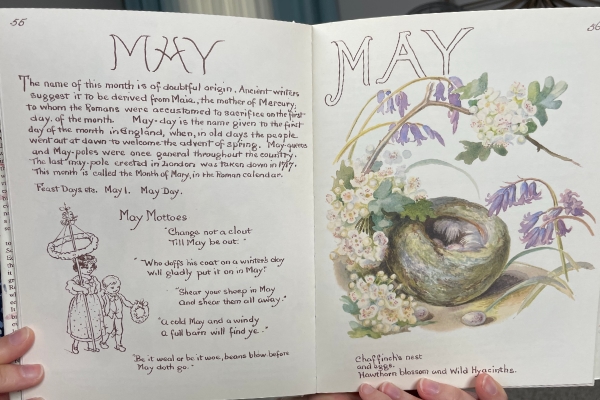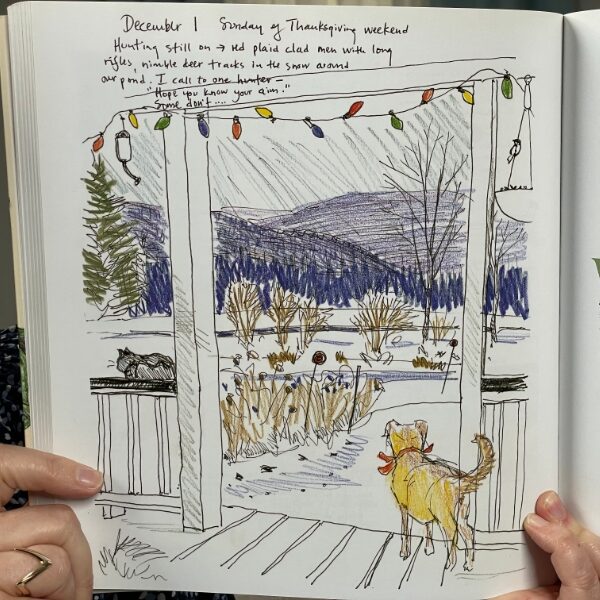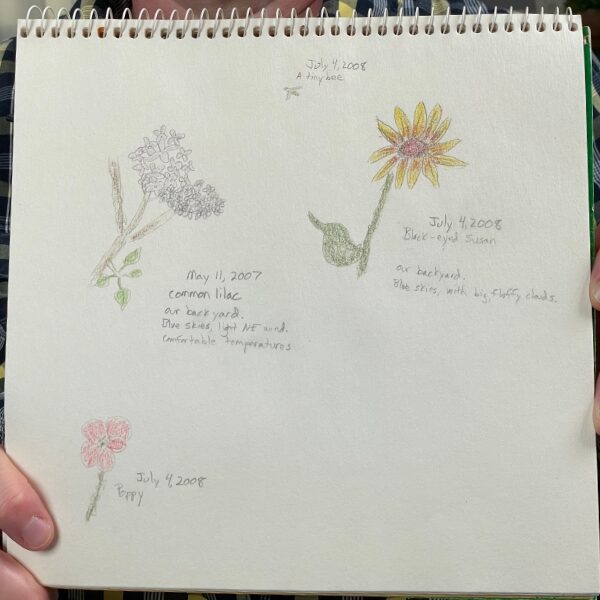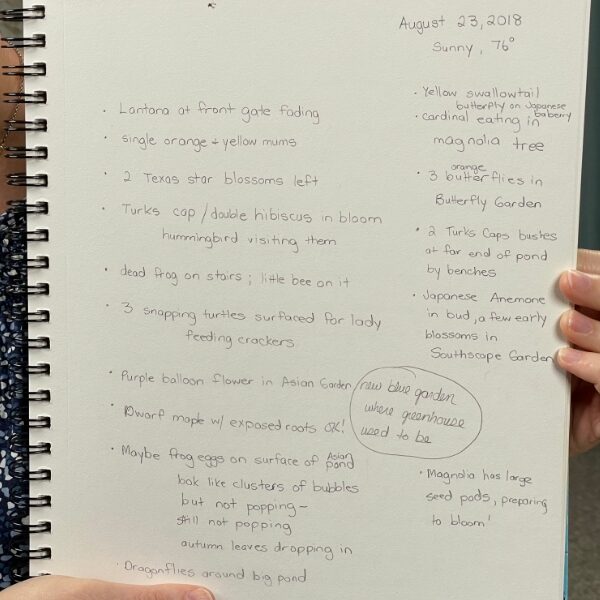Free shipping on USA orders over $129!
Even if you don’t draw or paint very well, you can still keep a wonderful nature journal. Charlotte Mason often talked about adding images to our nature journal by painting them or drawing them. But what do you do if you’re not very good at painting or drawing, or if you don’t enjoy it very much? Can you still keep a good nature journal? That’s what we want to talk about today. And here to help me is my friend, Karen Smith.
Sonya: Karen, I am not that great at painting and drawing.
Karen: I am not either.
Sonya: So we’re kind of in the same boat when it comes to our nature journals. But let’s back up, say what the purpose of nature study is, and then we’ll talk about how the nature journals help us get there. That will give us the bigger picture. So first, what’s the purpose of nature study?
Karen: It’s to cause you to stop, look at the creation, and to notice differences, similarities, how things are formed, how things move, how things eat, how they change, how they grow. All of those things that happen in nature, that if we just walk right by and give them a glance, we’re not going to notice. One of the things for me with nature study is how much observing nature causes me to praise God for what He has created. And to me, that’s the ultimate in nature study.
One of the things for me is how much observing nature causes me to praise God for what He has created. To me, that’s the ultimate in nature study.
Sonya: Charlotte talked about that. That all creation praises God, and we should marvel more and more as we learn it, and about it more and more.
Karen: There’s much to marvel at when we stop to notice.
Sonya: So how then can drawing, painting, or creating those images in the nature journal help us attain that goal?
Karen: Drawing, painting, or even just jotting down notes of your observations, really cause you to stop and pause because you have to take the time if you’re going to write something down, or if you’re going to draw it, or paint it, to notice what is there. If you’re not, as I said, you give it a passing glance. “Oh, that’s a pretty flower,” and you move on. But when you take that time, “I’m going to write something about this,” or “I want to draw that, paint it, capture it somehow on paper.” Now you have to look more closely to notice all the details.
Sonya: It seems like drawing or painting takes longer. Let’s put it in steps. Writing a description of what you saw takes longer than just glancing at it and moving on. It seems to me like drawing or painting what I saw takes longer than just writing about what I saw.
Karen: Not necessarily. It depends on how long you’re going to observe it when you’re writing about it, and what details you’re going to look for, because you’re looking for those details so you can write about those. It’s the same process that you are going through to look at the details as you are sketching or painting.
Sonya: That’s a good point because I have an example of from my nature notebook here. I just wrote down “two Texas Star blossoms left.” That didn’t take me very long, but it doesn’t say what they looked like. It doesn’t say how big they were; it doesn’t say where they were. So even in my writing, this is probably the step between glancing and moving on and actually writing a good description. I think I was taking a shortcut here.
Karen: But you still wrote something down, and that’s important because the next time you see those, you may pause longer and learn more about it.
Sonya: Or notice that they’re gone. And then I would know when they bloom and when they don’t.
Karen: Yes, and those are little details you can add to that store of knowledge over time. You’re not going to learn everything about whatever you’re observing in that one time that you stop to pause. That’s something that is continuing, ongoing.
Sonya: So let’s be brave and show an example of each of our notebooks. I’ll show an example of my nature notebook if you’ll show an example of yours.
Karen: Certainly.
Sonya: Let’s show the good ones first. This is The Country Diary of an Edwardian Lady. This is the standard that everybody points to for nature study, and mine is never going to look like this. Never. I mean, I cannot paint like that and I would say yet, but I don’t know if I ever would get to this point. And my handwriting does not look like this.


Karen: Mine certainly does not.
Sonya: And the little sketches down here, it’s like cue the angel choir. “This is is so beautiful.” (sings)
Karen: And some people’s nature diaries are going to look like that.
Sonya: Oh yes. Because some people are more artistic than we are. Well, even Claire Walker Leslie. With hers, she is much more informal than Edith Holden.


Karen: Yes, you can see where hers is more sketched out.
Sonya: But still, I don’t know that I could sketch like that unless that’s all I concentrated on for a year or so. Maybe then I could get up to that point. So now let’s show what ours look like. You go first.
Karen: Okay, well I just picked. I chose this page.


Sonya: Now see, I can tell what those flowers are. That’s wonderful. They’re so totally different. And you captured the essence, the essentials of each one, so you’d be able to identify it again later.
Karen: Yes, and this is from somebody who can’t draw a straight line with a ruler. But I amazed myself what I could do when I slowly drew something as I was looking at it. For most of these, I also jotted down a few notes, also. So you can do both, or you can do one or do the other.
Sonya: That’s pretty much what I did on this one. I just walked around my favorite park and jotted down my observations as I walked around it because it wasn’t so much a nature study as a nature walk, and I wanted to record what I saw, what I didn’t see, what had changed since last time to, as you said, add to my store of knowledge about that place. But there are no sketches, no paintings, no drawings here.


Karen: And that’s okay, because nature journals are what you make of them. And each of us is an individual. So my nature journal is not going to look like yours, and neither of ours are going to look like those. So, if you don’t enjoy drawing, you don’t have to draw. Just write down your observations. Sometimes even taking a photograph of it, and I don’t mean snapping a picture so you can identify it, I mean taking the time to frame that nicely and noticing the things around it, can also cause you to stop and observe. But it also gives you a picture you can put in your nature journal if you want to, if you want to print it out and put it there. But there are different approaches to nature journaling and none of them are wrong.
Sonya: It seems like the whole thing is to slow down and take the time to observe all that you can in that moment about that particular nature friend.
Karen: Yes. And I find for myself that the more I learn about things in nature, the more in awe of God that I am. Because what he created is so intricate, and we only find that out by looking at it closely and observing it.
Sonya: That reminds me of something I was just reading yesterday. The author made an interesting comment about how God does not compare his children to each other. And so often I think we get hung up, comparing our nature notebook to the Country Diary, or even siblings can get hung up comparing.
Karen: “I can’t draw as well as my big brother or big sister.”
Sonya: Right, and that becomes a deterrent to doing nature study. How can we encourage our children not to compare, but to make their own nature journal a reflection of their own discoveries and a record of what they, as individuals, have discovered?
Karen: Part of the job of the parent at that point is to help each child find his or her strength and then concentrate on that for their nature journal. “I know you can’t draw as well as your sister.”
Sonya: Yet.
Karen: “But you can tell me what you’ve observed and I can write that down for you.” Or, “You can give it a try and it’s okay if yours doesn’t look like your brother’s because you’re different. You’re both unique individuals and that’s okay. This is yours and that’s his. You make yours, yours.”
Sonya: I like that idea. You make yours, yours. Because Charlotte was so much about the child is a person and respecting each child. And I love how the nature notebook is so much like other notebooks that she encouraged us to keep. It is such a personal thing. It starts out blank and you make it a reflection of you.
Karen: Yes, very much so. So what you put in your book of centuries is not going to be the same as what I put in mine. There may be some overlap, but there will be different events and people in history that you’re going to connect better with, and some I’m going to connect better with. That’s going to be reflected in that book of centuries.
What I put in my notebook is going to be what I connected with, and that’s not going to be the same for you.
Sonya: And even how we record it. I have a friend, his book of centuries is all sketches and captions.
Karen: Yes, mine would be all writing.
Sonya: Mine is lists, yes.
Karen: And it’s the same with your book of mottoes. What I put in mine is going to be what I connected with, and that’s not going to be the same for you. Our life experiences are different.
Sonya: Yes, so let’s bring that over to nature notebooks as well. It’s what I observe or what catches my eye as we do our nature study, and it might be different from what you observe. Or I might prefer to record it in a different way than you do, but the end goal is to observe and praise God because of what we observe. We can all do that in our own way.
Karen: Yes.
Sonya: Thanks.
Podcast: Play in new window | Download
Podcast (podcastv): Play in new window | Download

Do you have a recommendation for good-quality colored pencils, markers, and watercolors? I know to avoid the “student” quality” 🙂
Hi Melissa,
This may be more of a personal preference over time. My family personally loves the Winsor and Newton pocket watercolor set so we can take it with us easily on our nature journaling outings. As far as markers and colored pencils, we typically gravitate towards crayola just due to our family’s budget and ease of local access to get more when we need them. Blick Art Supplies also has many wonderful options if you’re looking for something of higher quality.